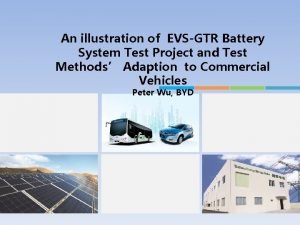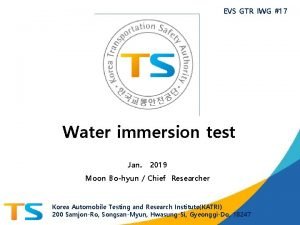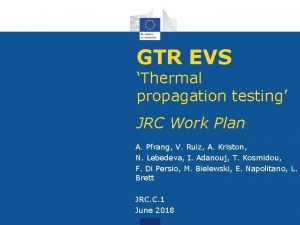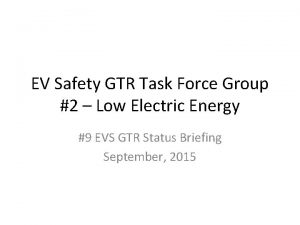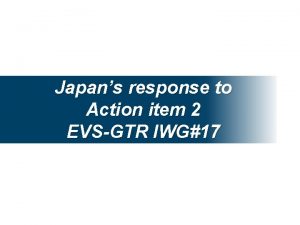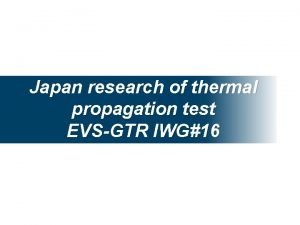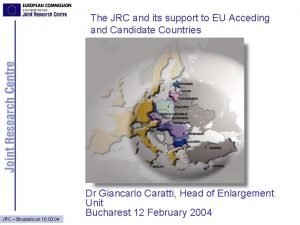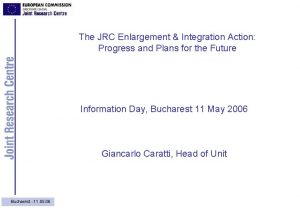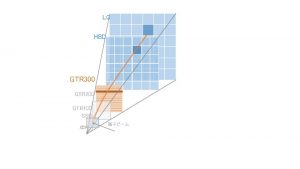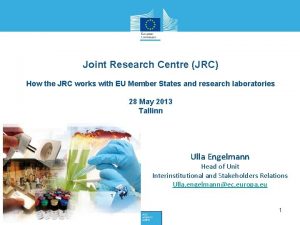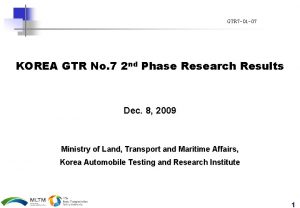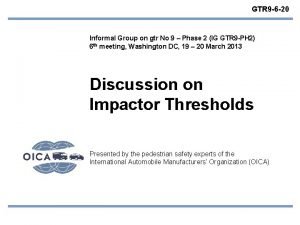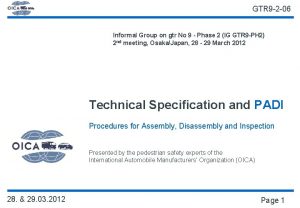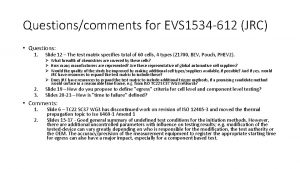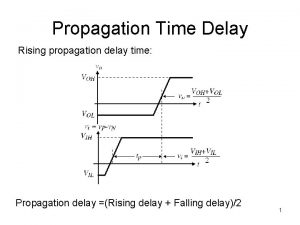GTR EVS Thermal propagation testing JRC Work Plan









- Slides: 9

GTR EVS ‘Thermal propagation testing’ JRC Work Plan A. Pfrang, V. Ruiz, A. Kriston, N. Lebedeva, I. Adanouj, T. Kosmidou, F. Di Persio, M. Bielewski, E. Napolitano, L. Brett JRC. C. 1 June 2018

Module Cell & material Comparison of initiation techniques • Trigger energy/ energy release • Repeatability + ARC, DSC Short stack Analyse influential factors on the outcome • Temperature, SOC… • Cell configuration • Spark source Narrow down init. methods Pack, Vehicle Verification and finalization of method • Round robin tests Evaluate repeatability, • Practical aspects reproducibility • Define robust • Check proposed test evaluation methods descriptions (also with (e. g. gas analysis) testing bodies) • Round robin tests • Define pass/fail criteria Refine test description Select equivalent test(s)

Thermal propagation Phase Test details Finalisation (expected) Cell and material level Development of thermal runaway (TR) model 1 st half 2018 TR model validation 2 nd half 2018 Review of standards 2 nd half 2018 Experimental testing: comparison of initiation techniques 1 st half 2019 Experimental testing: analysis of TP 1 st-2 nd half 2019 TP simulation and validation 2 nd half 2019 Short cell stack Module / REESS Comparison of the proposed test level descriptions *Depending on the GTR progress Vehicle level *Depending on the GTR progress Validation of the selected method(s)

GTR EVS ‘Electrolyte leakage and venting’ JRC Work Plan N. Lebedeva, T. Kosmidou, R. Da Costa Barata, L. Boon-Brett JRC. C. 1 June 2018

Electrolyte leakage/venting verification Current state of the art "…visual inspection without disassembling any part of the Tested. Device" is adopted in Phase 1 as a method for verification of the occurrence of electrolyte leakage and venting. JRC concerns: • • Due to high volatility of some electrolyte components and limited release volume, electrolyte leakage and venting may not always be easily detectable, while potentially creating hazardous environment. • Special measures may be required to ensure safety of inspecting personnel. • Release of other substances, e. g. coolant, is currently treated equally to release of electrolyte. JRC work will focus on the development of more robust method(s) to first verify the occurrence of the electrolyte release and/or venting and, if possible, to quantify such release.

Approaches to release detection 2 Vapours from released liquid electrolyte 3 Vented gases 2 Vapours from released liquid electrolyte time 1 Liquid electrolyte release 1 Solid(-liquid) electrolyte residue Possible approaches for detection of electrolyte release 1 Detection of Li-ion presence 2 + 3 Gas detection 3 Vented gases

Approaches to release detection Currently 'an appropriate coating' is indicated as technique for electrolyte leakage detection: 6. 1. 6. 2. 6. Electrolyte leakage. An appropriate coating, if necessary, may be applied to the physical protection (casing) in order to confirm if there is any electrolyte leakage from the REESS resulting from the test. Unless the manufacturer provides a means to differentiate between the leakage of different liquids, all liquid leakage shall be considered as the electrolyte. JRC research on detection of Li ion presence will also investigate and potentially provide guidance on the characteristics an appropriate coating could have.

1. Detection of Li ion presence Test details Finalisation (expected) 1 Proof-of-concept: model electrolyte Q 3 2018 2 Influence of test parameters, e. g. : - temperature - time - coolant, casing (plastic, metal) - Li+ concentration Q 4 2019 3 Tests with real electrolytes Q 2 2020

2+3. Gas detection Test details Finalisation (expected) 1 Method requirements Q 4 2018 2 Review analytical methods Q 1 2019 3 Method selection Q 1 2019 4 Tests with individual model compounds Q 3 2019 5 Tests with model mixtures and feasibility check Q 2 2020 6 Tests with real-world mixtures in an enclosed environment Q 4 2020 7 Tests with real-world mixtures in open air environment Q 2 2021
